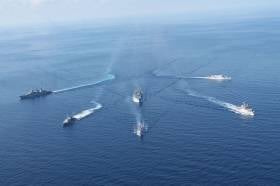Displaying items by tag: Homecoming for Christmas
L.É. Niamh Arrives Home in Time for Christmas Having Carried Out Historic Naval First Operation
#LENiamhHomecoming - L.É. Niamh returned to Cork Harbour anchorage overnight just in time for Christmas, having carried out a new historic first for the Irish Naval Service in the participation of Operation Sophia, writes Jehan Ashmore
Afloat continued tracking the OPV80 'Róisín' class patrol ship as of this mid-morning, L.É. Niamh weighed anchor in lower Cork Harbour to make the short passage to Haulbowline Naval Base and under the escort of tug, Gerry O'Sullivan. On board were a 55-strong crew planning to wear Santa hats under the command Lt Cdr Stuart Armstrong. Awaiting them were families and loved ones looking forward to sharing the festive period.
As previously reported on Afloat, the OPV80 class L.E. Niamh had departed Cork in October for the three-month deployment. This involved working as part of European Naval Force Mediterranean - Eunavfor Med Operation Sophia that consisted of a six-strong naval flotilla task force off the coast of Libya to neutralise people-smuggling operations.
Operation Sophia saw the interception of boats used by the smugglers from the Libyan coast and returning the migrants to north Africa.
In late November, the Eunavfor flotilla met to conduct exercises and crew exchanges taking advantage of tactical situations. During this rendez-vous, they kept performing operational tasks, obtaining information and controlling maritime traffic.
Last week, the Spanish auxiliary supplies ship Cantabria moored in Taranto, an Italian Naval base. On board a command change ceremony took place of Operation Sophia Task Force that saw the transfer from the Spanish to the duty of Force Commander of the Italian Navy.
Afloat also last week tracked down L.É. Niamh when south of Sicily, as the OPV had departed from the Ionian Sea port of Augusta on the Italian mainland.






























































